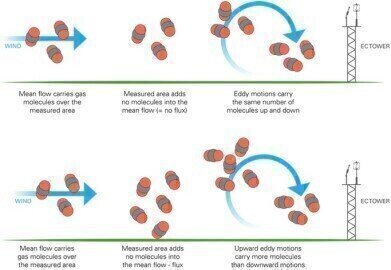Air Monitoring
Directly Measure Gas Emissions in Industrial and Monitoring Applications
Aug 19 2013
Dr. George Burba, LI-COR (USA) Principal Scientist, has written a comprehensive step-by-step instruction book (Burba G., Eddy Covariance Method for Scientific, Industrial, Agricultural and Regulatory Applications. LI-COR Biosciences; 2013) to assist non-meteorologists in using a cutting-edge technique to directly measure gas emissions in industrial and monitoring applications. This book guides the reader through a brief theory of the method, experiment design, implementation, data processing, and analysis. Free PDF copies can be downloaded at www.licor.com/ec-book.
The eddy covariance (EC) method is an advanced approach for high-speed measurements of the transport of gases and heat from area surfaces into the atmosphere. Gas emissions and exchange rates are characterised from single-point in situ measurements using permanent or mobile towers, or moving platforms such as automobiles, helicopters, airplanes, etc.
Since the early 1990s, EC has been widely used by micrometeorologists for quantifying CO2, CH4, and H2O emissions from natural, urban and agricultural ecosystems. Over 600 EC stations are now in operation in over 120 countries. In the last 3-5 years, methodological advancements have reached the point where EC can be easily used outside of micrometeorology, and is valuable for carbon capture and sequestration, leak detection, landfill emissions, and other industrial, regulatory, and monitoring applications.
To understand the basic principle, first imagine an area adding no gas molecules into the mean flow, and then compare it to the same area that adds molecules into the flow. Imagine a flow that carries 3 gas molecules over some area from left to right. The area in the middle did not add anything to the flow, so eddy movements at the downwind point would carry 3 molecules upward and 3 molecules downward, with no net flux.
Now imagine the surface adding 2 molecules to the flow. Since the area in the middle added 2 molecules to the flow, the eddy motions at the downwind point carry more molecules upward than downward. Thus, the EC station would measure a flux coming from the upwind area.
LI-COR Biosciences manufactures instruments that are ideal for making eddy covariance measurements, and also offers free instrument training. To learn more, visit www.licor.com/ec-analyzers.
Digital Edition
AET 28.2 April/May 2024
May 2024
Business News - Teledyne Marine expands with the acquisition of Valeport - Signal partners with gas analysis experts in Korea Air Monitoring - Continuous Fine Particulate Emission Monitor...
View all digital editions
Events
Jul 30 2024 Jakarta, Indonesia
China Energy Summit & Exhibition
Jul 31 2024 Beijing, China
2024 Beijing International Coal & Mining Exhibition
Aug 07 2024 Beijing, China
IWA World Water Congress & Exhibition
Aug 11 2024 Toronto, Canada
Aug 25 2024 Stockholm, Sweden and online









.jpg)








